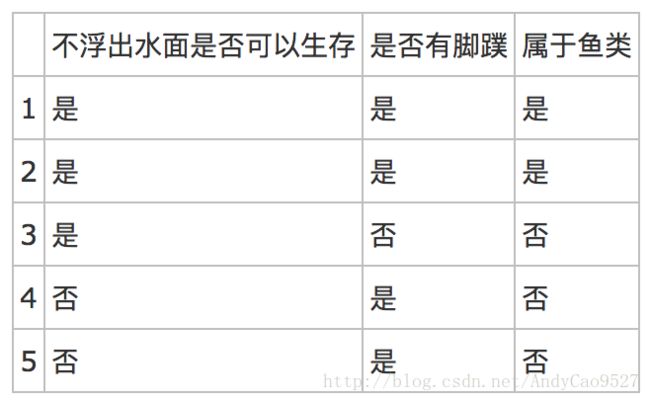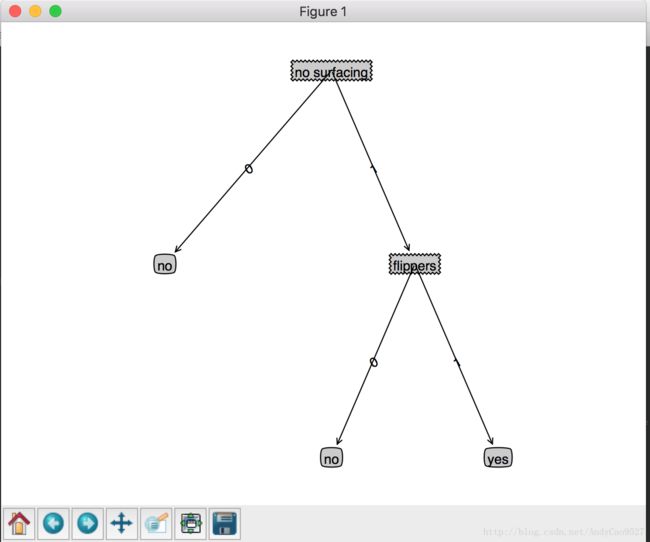机器学习实战第三章(决策树)
第二章介绍的k-近邻算法可以完成很多分类任务,但是最大缺点是无法给出数据的内在含义,决策树的主要优势就在于数据形式非常容易理解。
决策树:
优点:计算复杂度不高,输出结果易于理解,对中间值的缺失不敏感,可以处理不相关特征数据
缺点:可能会产生过度匹配问题
树用数据类型:数值型和标称型。
在构造决策树时,我们需要解决的第一个问题就是,当前数据集上哪个特征在划分数据分类时起决定性作用。为了找到决定性的特征,划分出最好的结果,我们必须评估每个特征。我们假设已经根据一定的方法选取了待划分的特征,则原始数据集将根据这个特征被划分为几个数据子集。这数据子集会分布在决策点(关键特征)的所有分支上。如果某个分支下的数据属于同一类型,则无需进一步对数据集进行分割。如果数据子集内的数据不属于同一类型,则需要递归地重复划分数据子集的过程,直到每个数据子集内的数据类型相同。
创建分支的过程用伪代码表示如下:
- 检测数据集中的每个子项是否属于同一类型:
如果是,则返回类型标签
否则:
寻找划分数据集的最好特征
划分数据集
创建分支节点
对划分的每个数据子集:
递归调用本算法并添加返回结果到分支节点中
返回分支节点
决策树的一般流程:
- 收集数据:可以使用任何方法。
- 准备数据:树构造算法只适用于标称数据,因此数值型数据必须离散化。
- 分析数据:可以使用任何方法,构造树完成之后,我们应该检查图形是否符合预期。
- 训练算法:构造树的数据结构。
- 测试算法:使用经验树计算错误率。
- 使用算法:此步骤可以适用于任何监督学习算法,而使用决策树可以更好地理解数据的内在含义。
一些决策树算法使用二分法划分数据,本书并不采用这种方法。如果依据某个属性划分数据将会产生4个可能的值,我们将把数据划分成四块,并创建四个不同的分支。
本书将使用ID3算法划分数据集,该算法处理如何划分数据集,何时停止划分数据集(进一步的信息可以参见http://en.wikipedia.org/wiki/ID3_algorithm)。每次划分数据集我们只选取一个特征属性,那么应该选择哪个特征作为划分的参考属性呢?
表1的数据包含5个海洋动物,特征包括:不浮出水面是否可以生存,以及是否有脚噗。我们可以将这些动物分成两类:鱼类和非鱼类。现在我们想要决定依据第一个特征还是第二个特征划分数据。在回答这个问题之前,我们必须采用量化的方法判断如何划分数据
信息增益
划分数据集的大原则是:将无序的数据变得更加有序。我们可以使用多种方法划分数据集,但是每种方法都有各自的优缺点。组织杂乱无章数据的一种方法就是使用信息论度量信息,信息论是量化处理信息的分支科学。我们可以在划分数据之前或之后使用信息论量化度量信息的内容。
在划分数据集之前之后信息发生的变化成为信息增益,我们可以计算每个特征划分数据集获得的信息增益,获得信息增益最高的特征就是最好的选择。
集合信息的度量方式成为香农熵或者简称为熵。
熵定义为信息的期望值。我们先确定信息的定义:
如果待分类的事务可能划分在多个分类之中,则符号xi定义为:

其中p(xi)是选择该分类的概率。
为了计算熵,我们需要计算所有类型所有可能值包含的信息的期望值,通过下面的公式得到:

其中n是分类的数目。
创建简单的鱼鉴定数据集
# -*- coding: UTF-8 -*-
from math import log
def createDataSet(): #创建数据集
dataSet = [
[1,1,'yes'],
[1,1,'yes'],
[1,0,'no'],
[0,1,'no'],
[0,1,'no']
]
labels = ['no surfacing', 'flippers']
return dataSet, labelsmyDat, labels = createDataSet() print myDat, labelsoutput:
[[1, 1, ‘yes’], [1, 1, ‘yes’], [1, 0, ‘no’], [0, 1, ‘no’], [0, 1, ‘no’]]
[‘no surfacing’, ‘flippers’]
程序清单3-1 计算给定数据集的信息熵
def calcShannonEnt(dataSet): #计算给定数据集的香农熵
numEntries = len(dataSet) #计算数据集中的实例总数
labelCounts = {}
for featVec in dataSet:
currentLabel = featVec[-1]
#print currentLabel
if currentLabel not in labelCounts.keys():
labelCounts[currentLabel] = 0
labelCounts[currentLabel] += 1
shannonEnt = 0.0
for key in labelCounts:
prob = float(labelCounts[key])/numEntries
shannonEnt -= prob * log(prob,2)
return shannonEnt代码说明:
- 首先,计算数据集中实例的总数。我们可以在需要时再计算这个值,但是由于代码中多次用到这个值,为了提高代码效率,我们显式地声明一个变量保存实例总数。
- 然后,创建一个数据字典,它的键值是最后一列的数值。如果当前键值不存在,则扩展字典并将当前键值加入字典。每个键值都记录了当前类别出现的粗疏。
- 最后,使用所有类标签的发生频率计算类别出现的概率。我们将用这个概率计算香农熵,统计所有类标签发生的次数。
熵越高,则混合的数据越多,我们可以在数据集中添加更多的分类,观察熵是如何变化的
print calcShannonEnt(myDat)output:
0.970950594455
myDat[0][-1]='caoxin'
print calcShannonEnt(myDat)output:
1.37095059445
得到熵之后,我们就可以按照最大信息增益的方法划分数据集。
另一个度量集合无序程度的方法是基尼不纯度(Gini impurity),简单地说就是从一个数据集中随机选取子项,度量其被错误分类到其他分组里的概率。
划分数据集 ##
上节学习了如何度量数据集的无序程度,分类算法除了需要测量信息熵,还需要划分数据集,度量花费数据集的熵,以便判断当前是否正确划分了数据集。我们将对每个特征划分数据集的结果计算一次信息熵,然后判断按照哪个特征划分数据集是最好的划分方法。
程序清单3-2 按照给定特征划分数据集
def splitDataSet(dataSet, axis, value):#三个输入参数:带划分的数据集、划分数据集的特征、需要返回的特征的值
retDataSet = []
for featVec in dataSet:
#print featVec
#print axis,value
if featVec[axis] == value:
reducedFeatVec = featVec[:axis]
reducedFeatVec.extend(featVec[axis+1:])
retDataSet.append(reducedFeatVec)
return retDataSetextend 和 append的却别
a=[1,2,3]
b=[4,5,6]
a.extend(b)
print aoutput:
[1, 2, 3, 4, 5, 6]
a=[1,2,3]
b=[4,5,6]
a.append(b)
print aoutput:
[1, 2, 3, [4, 5, 6]]
print myDat
print splitDataSet(myDat,1,1) output:
[[1, 1, ‘yes’], [1, 1, ‘yes’], [1, 0, ‘no’], [0, 1, ‘no’], [0, 1, ‘no’]]
[[1, ‘yes’], [1, ‘yes’], [0, ‘no’], [0, ‘no’]]
接下来遍历整个数据集,循环计算香农熵和splitDataSet()函数,找到最好的特征划分方式。熵计算将会告诉我们如何划分数据集释最好的数据组织方式。
程序清单3-3 选择最好的数据集划分方式
def chooseBestFeatureToSplit(dataSet):
numFeatures = len(dataSet[0]) - 1
baseEntropy = calcShannonEnt(dataSet)
bestInfoGain = 0.0
bestFeature = -1
for i in range(numFeatures):1
featList = [example[i] for example in dataSet]
uniqueVals = set(featList)
newEntropy = 0.0
for value in uniqueVals:
subDataSet = splitDataSet(dataSet, i, value)
prob = len(subDataSet)/float(len(dataSet))
newEntropy += prob * calcShannonEnt(subDataSet)
infoGain = baseEntropy - newEntropy
if (infoGain > bestInfoGain):
bestInfoGain = infoGain
bestFeature = i
return bestFeature- 本函数使用变量bestInfoGain和bestFeature记录最好的信息增益和对应的特征;
- numFeatures记录特征维数,依次遍历各个特征,计算该特征值的集合(uniqueVals);
- 遍历该特征计算使用该特征划分的熵(newEntropy),据此计算新的信息增益(infoGain);
- 比较infoGain和bestInfoGain记录信息增益的最大值和对应特征;
- 最终返回最大的信息增益对应特征的索引。
print chooseBestFeatureToSplit(myDat)output:
0
函数选取了第一个特征用于划分。
递归决策树构建
构造决策树所需的子功能模块已经介绍完毕,构建决策树的算法流程如下:
- 得到原始数据集
- 基于最好的属性值划分数据集,由于特征值可能多于两个,因此可能存在大于两个分支的数据集划分。
- 第一次划分之后,数据将被向下传递到树分支的下一个节点,在这个节点上,我们可以再次划分数据。我们可以采用递归的原则处理数据集。
递归结束的条件是,程序遍历完所有划分数据集的属性,或者每个分支下的所有实例都具有相同的分类。
添加如下代码:
def majorityCnt(classList): #返回出现次数最多的分类名称
classCount={}
for vote in classList:
if vote not in classCount.keys():
classCount[vote] = 0
classCount[vote] += 1
sortedClassCount = sorted(classCount.iteritems(), key=operator.itemgetter(1), reverse=True)
return sortedClassCount[0][0] 程序清单3-4 创建树的函数代码
def createTree(dataSet,labels):
classList = [example[-1] for example in dataSet] #包含了数据集的所有类标签
#递归函数第一个停止的条件是所有的类标签完全相同,则返回该类标签
if classList.count(classList[0]) == len(classList):
return classList[0]
#递归函数第二个停止的条件是使用完了所有的特征,仍然不能将数据集划分成仅包含唯一类别的分组
if len(dataSet[0]) == 1:
#majorityCnt函数统计classList列表中每个类型标签出现频率,返回出现次数最多的分类名称。
return majorityCnt(classList)
bestFeat = chooseBestFeatureToSplit(dataSet) #当前数据集选取的最好特征存储在变量bestFeat中
bestFeatLabel = labels[bestFeat]
myTree = {bestFeatLabel:{}} #将决策树存在字典中
del(labels[bestFeat]) #labels删除当前使用完的特征值的label
featValues = [example[bestFeat] for example in dataSet]
uniqueVals = set(featValues)
#递归输出决策树
for value in uniqueVals:
subLabels = labels[:]
myTree[bestFeatLabel][value] = createTree(splitDataSet(dataSet,bestFeat,value),subLabels)
return myTreemyTree = createTree(myDat,labels) print myTreeoutput:
{‘no surfacing’: {0: ‘no’, 1: {‘flippers’: {0: ‘no’, 1: ‘yes’}}}}
从数据集构造决策树算法工作原理:
得到原始数据集,然后基于最好的属性值划分数据集,由于特征值可能多于两个,因此可能存在大雨两个分支的数据集划分,第一次划分之后,数据将被向下传递到树分支的下一个节点,在这个节点上,我们可以再次划分数据。因此可以采用递归的原则处理数据集。
递归结束的条件是:
程序遍历完所有划分数据集的属性
或者每个分支下的所有实例都具有相同的分类
如果所有实例具有相同的分类,则得到的一个叶子节点或者终止块。任何到达叶子节点的数据必然属于叶子节点的分类
在python中使用Matplotlib注解绘制树形图
# -*- coding: UTF-8 -*-
import matplotlib.pyplot as plt
decisionNode = dict(boxstyle = 'sawtooth', fc = '0.8')
leafNode = dict(boxstyle = 'round4', fc = '0.8')
arrow_args = dict(arrowstyle = '<-')
def plotNode(nodeTxt, centerPt, parentPt, nodeType):
createPlot.ax1.annotate(nodeTxt, xy = parentPt, xycoords = 'axes fraction', xytext = centerPt, textcoords = 'axes fraction', va = 'center', ha = 'center', bbox = nodeType, arrowprops = arrow_args)
''' def createPlot(): fig = plt.figure(1, facecolor = 'white') fig.clf() createPlot.ax1 = plt.subplot(111, frameon = False) plotNode('a decision node', (0.5, 0.1), (0.1, 0.5), decisionNode) plotNode('a leaf node', (0.8, 0.1), (0.3, 0.8), leafNode) plt.show() '''
#createPlot()
def createPlot(inTree):
fig = plt.figure(1, facecolor='white')
fig.clf()
axprops = dict(xticks=[], yticks=[])
createPlot.ax1 = plt.subplot(111, frameon=False, **axprops) #no ticks
#createPlot.ax1 = plt.subplot(111, frameon=False) #ticks for demo puropses
plotTree.totalW = float(getNumLeafs(inTree))
plotTree.totalD = float(getTreeDepth(inTree))
plotTree.xOff = -0.5/plotTree.totalW; plotTree.yOff = 1.0;
plotTree(inTree, (0.5,1.0), '')
plt.show()
def getNumLeafs(myTree):
numLeafs = 0
firstStr = myTree.keys()[0]
#print firstStr
secondDict = myTree[firstStr]
#print secondDict
for key in secondDict.keys():
#print 'key = ', key
#print secondDict[key]
if type(secondDict[key]).__name__=='dict':
numLeafs += getNumLeafs(secondDict[key])
#print 'numLeafs0=', numLeafs
else:
numLeafs +=1
#print 'numLeafs1=', numLeafs
return numLeafs
def getTreeDepth(myTree):
maxDepth = 0
firstStr = myTree.keys()[0]
#print firstStr
secondDict = myTree[firstStr]
#print secondDict
for key in secondDict.keys():
#print key
#print secondDict[key]
if type(secondDict[key]).__name__=='dict':
thisDepth = 1 + getTreeDepth(secondDict[key])
#print 'thisDepth0=', thisDepth
else: thisDepth = 1
if thisDepth > maxDepth: maxDepth = thisDepth
return maxDepth
testTree = {'no surfacing': {0: 'no', 1: {'flippers': {0: 'no', 1: 'yes'}}}}
#print getNumLeafs(testTree)
#print getTreeDepth(testTree)
def plotTree(myTree, parentPt, nodeTxt):#if the first key tells you what feat was split on
numLeafs = getNumLeafs(myTree) #this determines the x width of this tree
depth = getTreeDepth(myTree)
firstStr = myTree.keys()[0] #the text label for this node should be this
cntrPt = (plotTree.xOff + (1.0 + float(numLeafs))/2.0/plotTree.totalW, plotTree.yOff)
plotMidText(cntrPt, parentPt, nodeTxt)
plotNode(firstStr, cntrPt, parentPt, decisionNode)
secondDict = myTree[firstStr]
plotTree.yOff = plotTree.yOff - 1.0/plotTree.totalD
for key in secondDict.keys():
if type(secondDict[key]).__name__=='dict':#test to see if the nodes are dictonaires, if not they are leaf nodes
plotTree(secondDict[key],cntrPt,str(key)) #recursion
else: #it's a leaf node print the leaf node
plotTree.xOff = plotTree.xOff + 1.0/plotTree.totalW
plotNode(secondDict[key], (plotTree.xOff, plotTree.yOff), cntrPt, leafNode)
plotMidText((plotTree.xOff, plotTree.yOff), cntrPt, str(key))
plotTree.yOff = plotTree.yOff + 1.0/plotTree.totalD
#if you do get a dictonary you know it's a tree, and the first element will be another dict
def plotMidText(cntrPt, parentPt, txtString):
xMid = (parentPt[0]-cntrPt[0])/2.0 + cntrPt[0]
yMid = (parentPt[1]-cntrPt[1])/2.0 + cntrPt[1]
createPlot.ax1.text(xMid, yMid, txtString, va="center", ha="center", rotation=30)
createPlot(testTree)
